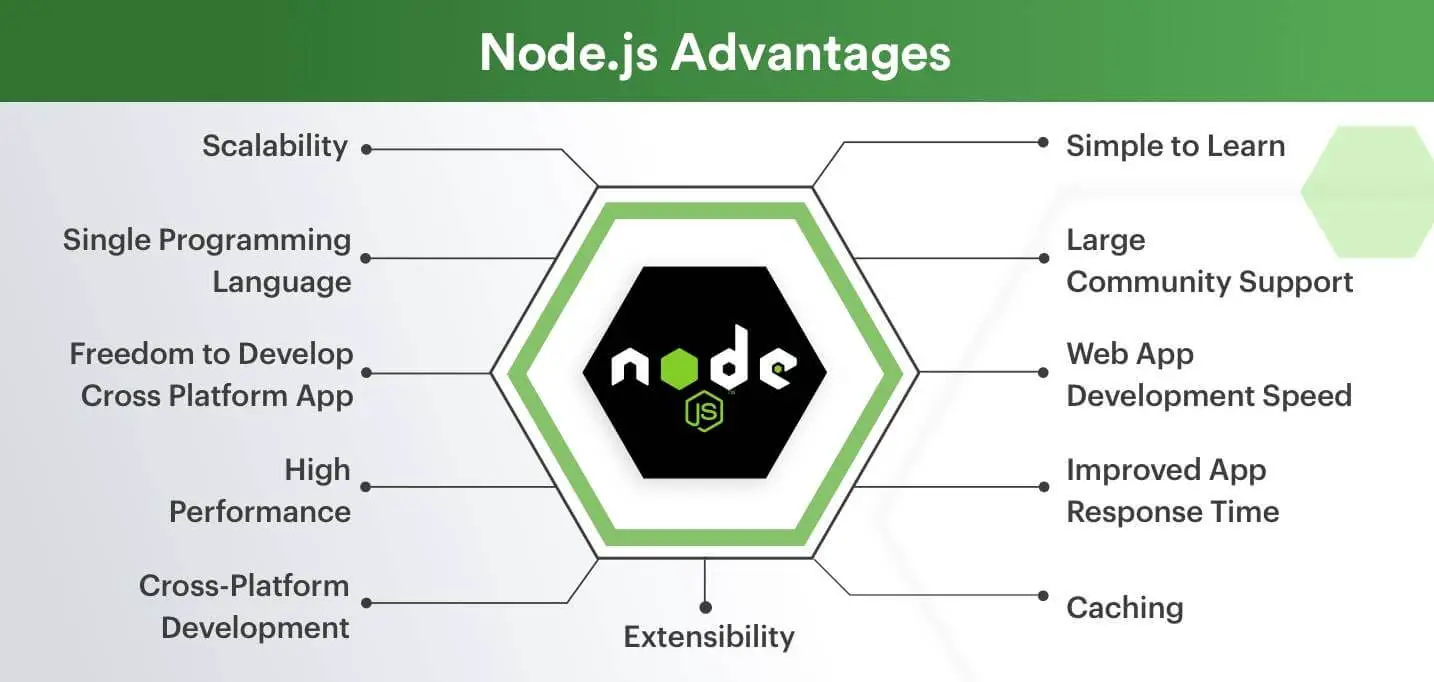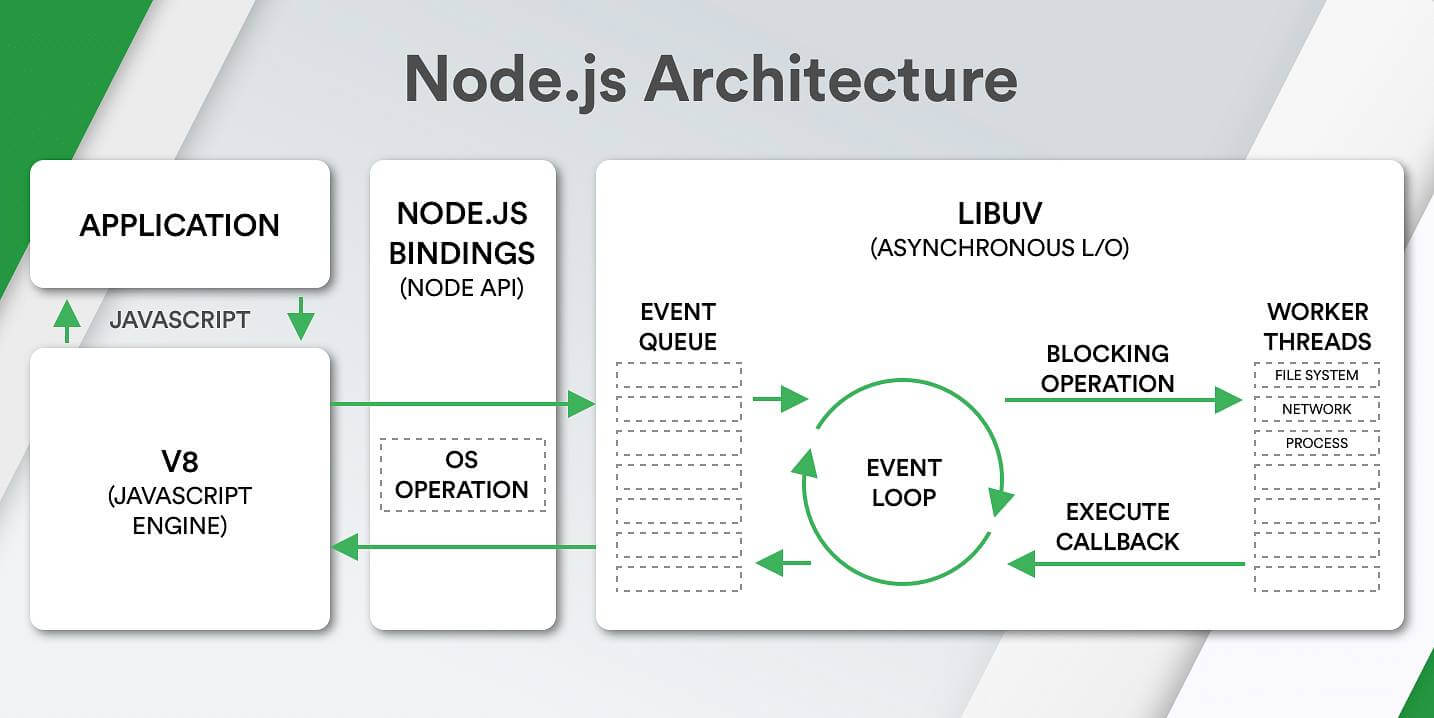Node.js The Ultimate Guide to Web Development
In this article, we will learn about Node.js is a powerful JavaScript runtime built on Chrome's V8 JavaScript engine. It allows developers to run JavaScript code on the server-side, enabling them to build scalable and high-performance web applications.
Traditionally, JavaScript was primarily used for client-side scripting in web browsers, but with Node.js, developers can leverage the same language and ecosystem to build server-side applications as well.
One of the key features of Node.js is its event-driven, non-blocking I/O model. This means that Node.js is designed to handle a large number of concurrent connections efficiently, making it suitable for building real-time applications, APIs, and other network-intensive systems.
By using asynchronous programming techniques, Node.js can handle multiple requests without blocking the execution of other code, resulting in improved performance and responsiveness.
In this guide, I'll provide you with an overview of Node.js and cover the key aspects of web development using Node.js.
Some popular frameworks for web development with Node.js include Express.js, Koa.js, and Hapi.js. These frameworks provide a structured approach to building web applications, offering features like routing, middleware support, and template rendering.
-
Introduction to Node.js:
- What is Node.js and why should you use it?
- Understanding the event-driven, non-blocking I/O model of Node.js.
- Installing Node.js and setting up the development environment.
-
Working with Node.js:
- Basic concepts of JavaScript and asynchronous programming.
- Building a simple server with Node.js using the built-in
httpmodule. - Handling HTTP requests and responses.
- Routing and middleware for building robust web applications.
- Working with the Express.js framework for easier routing and middleware management.
-
Working with Databases:
- Connecting to databases using Node.js.
- Querying databases using popular libraries like Mongoose (for MongoDB) or Sequelize (for SQL-based databases).
- Implementing CRUD operations (Create, Read, Update, Delete) with Node.js and databases.
-
Building RESTful APIs:
- Designing and implementing RESTful APIs with Node.js.
- Using Express.js to handle HTTP methods (GET, POST, PUT, DELETE) for API endpoints.
- Authentication and authorization using popular libraries like Passport.js or JSON Web Tokens (JWT).
- Implementing API versioning and error handling.
-
Real-time Applications with Node.js:
- Introduction to real-time communication using WebSockets and Socket.io.
- Building chat applications, live dashboards, or collaborative tools with Socket.io.
-
Testing and Debugging:
- Unit testing and integration testing with popular frameworks like Mocha and Chai.
- Debugging Node.js applications using built-in debugging tools or external tools like Visual Studio Code.
-
Deployment and Scalability:
- Deploying Node.js applications to various hosting platforms like Heroku, AWS, or Azure.
- Load balancing and scaling Node.js applications using techniques like clustering or containerization.
-
Performance Optimization:
- Identifying and resolving performance bottlenecks in Node.js applications.
- Caching, optimizing database queries, and using other performance-enhancing techniques.
-
Security Best Practices:
- Implementing security measures to protect Node.js applications.
- Handling user input validation, preventing common security vulnerabilities like XSS and CSRF attacks.
-
Additional Tools and Libraries:
- Overview of popular Node.js libraries and frameworks like GraphQL, Redis, Kafka, etc.
- Building real-world applications and integrating additional tools as needed.
Node.js comes with several powerful features that make it a popular choice for server-side development. Let's explore some of its key features:

-
Asynchronous and Non-blocking I/O: Node.js is designed around an event-driven, non-blocking I/O model. It uses asynchronous programming techniques to handle multiple concurrent requests without blocking the execution of other code. This allows for efficient handling of I/O-intensive operations, such as reading from or writing to files, making network requests, or interacting with databases.
-
Scalability and Performance: Due to its non-blocking I/O model, Node.js can handle a large number of simultaneous connections efficiently. This makes it highly scalable and well-suited for building real-time applications, chat servers, streaming services, and other applications that require handling a high volume of concurrent connections. Node.js also performs well in terms of response time and throughput.
-
JavaScript Everywhere: Node.js enables developers to use JavaScript not only on the client-side but also on the server-side. This allows for code reusability, as developers can share code and modules between the client and server, resulting in improved productivity and a unified development experience.
-
Vibrant Ecosystem and Package Manager (npm): Node.js has a vast ecosystem of open-source libraries and frameworks available through npm, the Node Package Manager. npm allows developers to easily discover, install, and manage dependencies for their projects. With over a million packages available, npm provides a wide range of tools, libraries, and utilities to enhance development productivity.
-
Modularity and Reusability: Node.js promotes modular programming by encouraging the use of modules to encapsulate and organize code. Developers can create reusable modules and share them across projects or publish them on npm for others to use. This modularity helps in maintaining clean and manageable codebases.
-
Server-side JavaScript Execution: Node.js allows developers to execute JavaScript code on the server-side, enabling them to handle server-related tasks, manipulate files, interact with databases, and implement server logic using a familiar programming language. This simplifies the development process by eliminating the need to switch between different languages for client-side and server-side development.
-
Cross-platform Compatibility: Node.js is cross-platform and can be run on various operating systems, including Windows, macOS, and Linux. This allows developers to write code once and deploy it on different platforms without major modifications, increasing code portability and reducing development effort.
Node.js follows a unique architecture known as the event-driven, non-blocking architecture, which plays a significant role in its performance and scalability. Let's explore the key components and concepts of Node.js architecture:

-
V8 JavaScript Engine: At the core of Node.js is the V8 JavaScript engine, developed by Google. It provides the runtime environment for executing JavaScript code. V8 compiles JavaScript into machine code, optimizing performance and enabling efficient execution.
-
Event Loop: The event loop is the heart of Node.js architecture. It allows Node.js to handle multiple concurrent requests efficiently. The event loop continuously checks for events and executes associated callbacks when an event occurs. It ensures that the execution remains non-blocking by delegating I/O operations to the underlying operating system and handling them asynchronously.
-
Single-Threaded, Non-Blocking I/O: Node.js operates on a single-threaded event loop model. Unlike traditional multi-threaded approaches, Node.js uses a single thread to handle multiple connections concurrently. This thread executes the event loop, managing all I/O operations asynchronously. Non-blocking I/O operations allow Node.js to handle numerous concurrent connections without creating a new thread for each request, resulting in high scalability and efficient resource utilization.
-
Callbacks and Asynchronous Programming: Asynchronous programming is a fundamental aspect of Node.js. It relies heavily on callbacks, which are functions passed as arguments to other functions. When an asynchronous operation completes, Node.js invokes the associated callback, allowing the application to handle the result or perform further actions. Asynchronous programming helps prevent blocking and keeps the event loop free to process other requests while waiting for I/O operations to complete.
-
Event Emitters: Node.js leverages the event emitter pattern for handling events and implementing event-driven programming. Event emitters allow objects to emit named events and attach listeners (callbacks) to respond to those events. This pattern is extensively used in Node.js modules and frameworks, enabling developers to build event-driven applications easily.
-
Modules and npm: Node.js promotes modular programming by breaking down applications into reusable modules. Modules encapsulate related functionality and can be shared and reused across projects. The Node Package Manager (npm) is the default package manager for Node.js, providing a vast ecosystem of open-source modules. npm allows developers to install, manage, and publish modules, facilitating code sharing and collaboration.
-
Libuv: Libuv is a cross-platform library that provides asynchronous I/O operations and abstracts the underlying operating system interfaces. It acts as a bridge between Node.js and the operating system, handling tasks such as file system operations, networking, timers, and more. Libuv enables Node.js to achieve its non-blocking and event-driven behavior across different operating systems.
Node.js architecture combines these components to provide a scalable, high-performance environment for building server-side applications.
You might also like:
- Read Also: How To Override Auth Login Method In Laravel 10
- Read Also: How To Generate PDF File In Node JS Using PDFKit
- Read Also: How To Push Array Element In Node.js
- Read Also: Node.js Express CRUD Example With MySQL








